


Christmas Store
The holidays are just around the corner so now is the time to fetch the finest gifts for the Labrador Lover on your Christmas list. We have over 100 gifts $50.00 and under. Visit our Christmas Store.
For the Lab
Bedding
Coats
Collars and Leads
Dog Bowls
Feeding Stations
Spa and Grooming
Toys and Treats
Travel and Accessories
For the Lab Lover
Apparel
Cards and Giftwrap
Fine Accessories
Gifts and All Occasions
Jewelry
Kids Only
For the Lab Home
Artwork
Books
Garden and Outdoor
Home Furnishings
Kitchen Accessories
Pillows, Throws, and Rugs
Gift ServicesGift Boxes
Gift Certificates
Brush Up On Dental Care
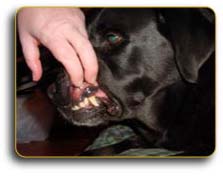
Dental care is a little known yet absolutely necessary component of caring for your dog. Dogs use their mouths not only to eat and drink, but also to communicate, groom, play, and socialize. A healthy mouth is vital for adequate performance of all these roles. However, dogs, like people, aren’t invincible to dental and gum disease. According to the American Veterinary Dental Society, eighty percent of all dogs show signs of periodontal (gum) disease by the age of three. Periodontal disease is one of the most common conditions seen by veterinarians today. Too often we overlook the need for dental care for our dogs, which is a shame, because good dental care can add as much as five years to your dog’s life.
The problem begins when plaque and tartar are allowed to build up on your dog’s teeth. Plaque harbors the bacteria, which can infect gum tissue and the roots of teeth. Tartar, or calculus, forms when minerals from saliva cause plaque on the teeth to harden. If plaque and the resulting calculus are left to accumulate on the teeth, bacteria quickly multiply and invade the gums around the teeth, causing an inflammation known as gingivitis. This inflammation of the gums can spread to the bone around the teeth, leading to bone loss or periodontal disease. Without adequate bony support, teeth may become loose, or even fall out. Dogs that can’t chew well also risk nutritional problems. They won’t live as long, perform as well, look as good, or be as happy. In severe cases of dental disease, bacteria from the mouth can get into the bloodstream, leading to kidney, liver or cardiac problems. Unfortunately, many times our four-legged companions suffer in silence, since they do not have a way to complain about their dental pain. Also, many owners are not aware of the signs or treatment of gum and dental disease.
Here are some signs and symptoms of potential gum and dental disease:
-
Persistent bad breath
-
Sensitivity around the mouth
-
Loss of appetite
-
Pawing at the mouth or face
-
Plaque (often not visible unless stained)
-
Bleeding, inflamed, or receded gums
-
Tartar (creamy-brown, hard material)
-
Loose or missing teeth
-
Difficulty eating and chewing food
-
Drooling, sneezing or eye tearing
The Progression of Gingivitis to Periodontal Disease
Mild Gingivitis -
Margin of attached gingiva (gum) is inflamed and swollen. Plaque covers teeth. Treatment can reverse condition.
Moderate Gingivitis -
Entire attached gingiva (gum) is inflamed and swollen. Mouth is painful and odor begins to be noticeable. Professional treatment and home dental care can prevent this from becoming irreversible.
Severe Gingivitis -
Cherry red and bleeding attached gingiva (gum). Gingiva is becoming destroyed by infection and calculus (tartar). Sore mouth affects the dog’s eating and behavior. Bad breath is present. Beginning of periodontal disease. May become irreversible.
Periodontal Disease -
Chronic bacterial infection is destroying the gum, tooth, and bone. Bacteria is spreading throughout the bloodstream and may damage the kidneys, liver and heart.
Caring for your Lab’s teeth
The first step is to determine your dog’s current state of mouth cleanliness. If you’re lucky, your examination of your dog’s teeth will reveal nothing but strong, white teeth surrounded by tight, pink gums. If that is the case, keep doing whatever you are doing for your Lab. However, if you can’t stand the smell to get close enough to look, you want to start right away with an appointment with your veterinarian for a thorough cleaning. Veterinarians often find that chronically ill dogs quickly improve after professional dental cleaning and resolution of oral infections. Routine periodontal treatment performed by a veterinarian includes ultrasonic scaling, subgingival manual scaling, and polishing. All of this cleaning will require your Lab to be put under anesthesia. A good way to remember to schedule a dental exam is to combine it with your dog’s annual booster vaccinations.
Equally important to annual dental exams is home dental care, such as brushing your dog’s teeth, or when brushing is not practical, some veterinarians may recommend an antibacterial oral rinse or gel, that can help slow accumulation of dental plaque. But have your veterinarian check for and take care of dental problems before beginning at-home brushing, so you don’t brush a painful mouth. If it hurts, your dog will probably resist.
Since toothbrushing is considered the most effective method of removing plaque, most veterinarians recommend an oral hygiene program that starts early in a dog’s life, at least by 5 or 6 months of age, when the puppy’s permanent teeth come in. However, older dogs are never too old for toothbrushing. In fact, the older your dogs gets, the more important it is to keep plaque and tartar from accumulating. Whether you are starting with your puppy or introducing an older dog to daily oral hygiene, remember that this should be fun for you and your dog.
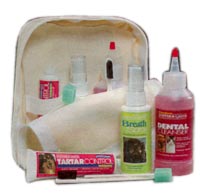
Where to Begin
Brushing your dog’s teeth is easy and doesn’t take much time. To begin with, select a convenient time when you and your Lab are both relaxed. Keep each session short and positive and be sure to praise your dog throughout the process. After each session, reward your dog with an appropriate treat and lots of praise.
-
For the first few days, simply hold your dog as you normally do when petting him. Do not overly restrain him. Gently stroke the outside of your dog’s cheeks with your finger for a minute or two. After your dog has become comfortable with this activity, dip a finger into beef bouillon and gently rub along the gums and teeth. Focusing on the gum line, start at the front of the mouth, then move to the back upper and lower teeth and gum areas. (Adult dogs have 42 permanent teeth, 20 on the top and 22 on the bottom.)
-
Once your dog is okay with a little bit of touching, gradually introduce gauze over your finger, (you can also dip into beef bouillon) and rub the teeth and gums in a circular fashion. Do this for one to two weeks until your dog is familiar with having his gums and teeth rubbed.
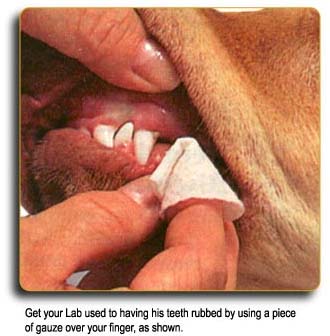
-
Place a small amount of pet toothpaste on your finger and let your dog sample the flavor. Pet toothpastes generally have a poultry, malt, or other flavor that your dog will like. Get your dog used to the flavor and consistency of the toothpaste. Let your dog lick some off your finger and then apply some to his gumline with your finger. After a few sessions, your dog should actually look forward to this and you can move on. Use only veterinary toothpaste, not baking soda or human toothpaste. Human toothpaste foams and contains fluoride, which can cause an upset stomach. Your dog can safely swallow meat-flavored veterinary toothpaste.
-
Next, introduce your dog to an animal toothbrush, fingerbrush, or a soft human toothbrush. Your dog needs to get used to the bristles on the brush, so let him lick some toothpaste off the brush so he gets used to the texture.
-
Now that your dog is used to the toothbrush and toothpaste, you are ready to start brushing. Place a small amount of toothpaste on the brush. Gently raise your dog’s upper lip and place the brush against an upper canine tooth (the large ones in the front of the mouth). These are the easiest teeth for you to start with. With a slow circular motion, gently brush only that tooth and the adjoining gumline. The bristles should be held at a 45 degree angle to the tooth surface. Each day gradually increase the number of teeth brushed, but go slowly. Do not go beyond your dog’s point of comfort. Build up to approximately 30 seconds of brushing per side. Remember, after each session, reward your pet with a treat and lots of praise.
-
Be patient, proceed slowly and gently. Use plenty of petting and praise. Soon, both you and your Lab will look forward to the time you spend together during this important health care procedure.
Certainly, the more often you brush the better. Aim for daily dental care for your Lab, just as you aim for daily dental care for yourself. The hardest thing about home dental care is just getting started. Once you have done it a while, it will become part of your daily routine. If you cannot brush daily, brushing every other day will remove the plaque before it has time to mineralize. This will still have a positive effect on your dog’s oral health.
Diet
Diet can be a major factor in the development of plaque and tartar. Avoid feeding dogs table scraps, soft, sticky foods, or sweet treats because they can increase the build up of plaque and tartar, and can contribute to subsequent periodontal disease. Dry food, biscuits, and newly formulated abrasive diets can be helpful in removing plaque above the gumline. In addition, providing your dog with specially treated dental chews is often a good alternative for those days when you do not brush. However, only toothbrushing can remove plaque and food debris below the gumline. It is below the gumline where disease causing bacteria flourish, resulting in irritation, inflammation and infection. Remember to provide fresh water daily. Bacteria can build up inside bowls containing water more than two days old.
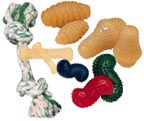 Toys
Toys
Plaque Attacker dental toys as pictured here, are helpful in the mechanical removal of plaque. Avoid chew toys of natural bone or cow hoof since these items are too hard and can create excessive teeth wear or fractures.
Looking for a Doggie Dentist?
To locate a veterinary dentist in your area, contact the American Veterinary Dental Society at (800)-332-2837(AVDS). It has more than 1,000 active members worldwide.
Submit your Lab’s smile
If you think your Lab has a great smile, send us a digital image! Maybe he or she will be our next featured smile.
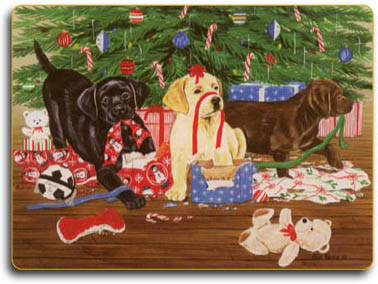 Can You Spot The Holiday Hazards?
Can You Spot The Holiday Hazards?It’s easy for pets, especially Labradors, to get into trouble during the holidays. You may get so busy that you lose track of what is going on with your dog.
Click here to learn more about: "Can You Spot The Holiday Hazards?"

Would you like to see your Lab pictured here? Send us images of your Lab and we may include them on our Home Page!
Labrador Links
The Verstaile Lab
History of the Lab
Advice
Travel
Featured Labs
Featured Artists
.jpg)

